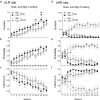Adolescent cocaine exposure enhances goal-tracking behavior and impairs hippocampal cell genesis selectively in adult bred low-responder rats
- PMID: 28210781
- PMCID: PMC5792824
- DOI: 10.1007/s00213-017-4566-0
Adolescent cocaine exposure enhances goal-tracking behavior and impairs hippocampal cell genesis selectively in adult bred low-responder rats
Abstract
Rationale: Environmental challenges during adolescence, such as drug exposure, can cause enduring behavioral and molecular changes that contribute to life-long maladaptive behaviors, including addiction. Selectively bred high-responder (bHR) and low-responder (bLR) rats represent a unique model for assessing the long-term impact of adolescent environmental manipulations, as they inherently differ on a number of addiction-related traits. bHR rats are considered "addiction-prone," whereas bLR rats are "addiction-resilient," at least under baseline conditions. Moreover, relative to bLRs, bHR rats are more likely to attribute incentive motivational value to reward cues, or to "sign-track."
Objectives: We utilized bHR and bLR rats to determine whether adolescent cocaine exposure can alter their inborn behavioral and neurobiological profiles, with a specific focus on Pavlovian conditioned approach behavior (i.e., sign- vs. goal-tracking) and hippocampal neurogenesis.
Methods: bHR and bLR rats were administered cocaine (15 mg/kg) or saline for 7 days during adolescence (postnatal day, PND 33-39) and subsequently tested for Pavlovian conditioned approach behavior in adulthood (PND 62-75), wherein an illuminated lever (conditioned stimulus) was followed by the response-independent delivery of a food pellet (unconditioned stimulus). Behaviors directed toward the lever and the food cup were recorded as sign- and goal-tracking, respectively. Hippocampal cell genesis was evaluated on PND 77 by immunohistochemistry.
Results: Adolescent cocaine exposure impaired hippocampal cell genesis (proliferation and survival) and enhanced the inherent propensity to goal-track in adult bLR, but not bHR, rats.
Conclusions: Adolescent cocaine exposure elicits long-lasting changes in stimulus-reward learning and enduring deficits in hippocampal neurogenesis selectively in adult bLR rats.
Keywords: Adolescence; Cocaine; Hippocampus; Neurogenesis; Pavlovian conditioning.
Conflict of interest statement
The authors declare the absence of any competing financial interests concerning the content of this document.
Figures






References
-
- Amrein I, Isler K, Lipp HP. Comparing adult hippocampal neurogenesis in mammalian species and orders: influence of chronological age and life history stage. Eur J Neurosci. 2011;34:978–987. - PubMed
MeSH terms
Substances
Grants and funding
LinkOut - more resources
Full Text Sources
Other Literature Sources

